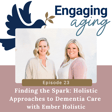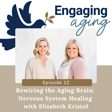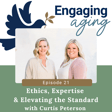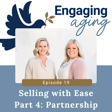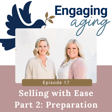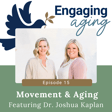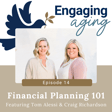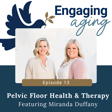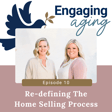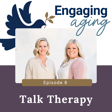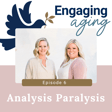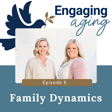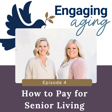Become a Creator today!Start creating today - Share your story with the world!
Start for free
00:00:00
00:00:01

Death by Suicide and the aging LGBTQIA+ Community
Join Lauren Watts and Joe Scott, Director of Move Management, at Dovetail Companies as they welcome Kirk Woodring to the podcast. Kirk is the Director of Behavioral Integration with AgeSpan, the Elder Services of Merrimack Valley and North Shore in Massachusetts. Kirk speaks out on suicide amongst older adults, aging, and its impact on LGBTQIA+ community. There are many factors that contribute to death by suicide among older adults, including: isolation, depression, loneliness, profound loss, and lack of family/supportive communities.
Help us raise awareness and start the conversation.
Transcript
Introduction to Engaging Aging with Erin and Lauren
00:00:03
Speaker
Welcome to Engaging Aging with Erin and Lauren. Join us as we share laughter, tears, and demystify the realities and silver linings that occur later in life.
Introducing Joe Scott and Kirk Woodring
00:00:16
Speaker
Welcome back. Today I'm joined with Joe Scott, our Director of Move Management. And we are diving into a topic that
00:00:27
Speaker
It's really hard, I think, for a lot of people to start to even fathom or think about, we a lot of times talk about positive aging. But today we are joined by Kirk Woodring, who is the Director of Behavioral Integration with AgeSpan, the Elder Services of Merrimack Valley and North Shore.
00:00:45
Speaker
And
Understanding Suicide in LGBTQ+ and Older Adults
00:00:46
Speaker
we had the pleasure of meeting Kirk during one of the conferences for the LGBTQ plus community and Kirk, you spoke a lot on suicide and especially amongst older adults, but the LGBTQ plus community as well.
00:01:05
Speaker
And I'm sure it's one of those topics that is not discussed too frequently. So welcome to the show. We would love to dive right in and really understand a little bit from you, but how did you become involved in this topic of conversation and give us a little bit of your background? So it's a tough subject, right? I mean, it's difficult to talk about and people typically want to avoid talking about suicide. Somehow I fell into it, I guess I didn't fall into it.
00:01:33
Speaker
Just starting college back in my early 20s, my brother was a teenager. He was a musician and was very involved in music and kind of the music scene, and he ended up overdosing.
00:01:51
Speaker
Unintentionally, well, or intentionally, we're not really sure, because he'd been very depressed and he took a bottle of pills and got some help right away. But through the years, he continued to present with suicidal ideation and he practiced suicide. So he rehearsed it over and over and over again. And eventually, when he was in his 40s, he died by suicide. And so for me, really going back into my 20s,
00:02:21
Speaker
Suicide has been a part of my life. It's been something I think about. Working with folks who are suicidal. And as I've run crisis teams, I've worked in hospitals, provided support for folks who are suicidal, getting them into hospitals when that's necessary.
Impact of Isolation on Mental Health
00:02:39
Speaker
And more recently, I've been thinking a lot about suicide and aging and how complex that is.
00:02:48
Speaker
particularly with the LGBTQ plus community, um, because of the intersection of dynamics that occur around suicidality and mental health post pandemic, um, and you know, pre, during, and then post pandemic, the isolation. So that's, um, you know, that's, I spent a lot of time thinking about this and talking with folks about it.
00:03:08
Speaker
I think a lot of people look at coming out of the COVID-19 pandemic and what we had to do just as human society. We are not meant to be on this earth and not be interacting with one another and be behind closed doors and within four walls and not really interacting with one another. What did you see come out of that pandemic amongst older adults?
00:03:32
Speaker
Well, I mean, I guess on the bright side, one of the things we found out was that older adults could access services in a way that maybe they hadn't been before. So if they have the access to technology, particularly video conferencing, there are a lot of services now that are available to them.
00:03:52
Speaker
That said, what we also saw, and this is true for everybody, not just with older adults, but particularly with older adults, is the loneliness that came from the isolation, the being cut off often from all of their support services or family members.
00:04:12
Speaker
I think that's been, that was pretty profound and it's continuing to have effects as time goes on. It's been difficult I think for a lot of folks to get back engaged in communities or even feel like they have supportive communities.
00:04:27
Speaker
When you look at older adults or really anyone that is struggling with suicide, and I appreciate you saying about your brother practicing suicide,
Mental Illness and Suicide Prevention
00:04:35
Speaker
right? He had obviously attempted multiple times to take his life. Do you always think that there is a mental health component behind that? Or do you think that that loneliness and what people experience can really drive them towards ending their life?
00:04:49
Speaker
Well, I mean, somewhere around 60 to 65% of folks who die by suicide have a diagnosed mental illness. That said, there are folks that make attempts and are actually successful at their attempts of dying by suicide who do it maybe impulsively, who are acting on an impulse that's going on, something, you know, a profound loss or, you know, something that is driving them to that point.
00:05:18
Speaker
And it happens very quickly. Those are ones that we don't necessarily feel like we can have a big effect on, that impulsivity. We can work with people around their impulsivity and when they feel these impulses to hurt themselves or to attempt suicide. But when somebody acts impulsively, it's difficult to be able to actually feel like we've had any opportunity to help mitigate the risk.
00:05:42
Speaker
For folks who have practiced suicide, have rehearsed it, we probably have a better chance of working with them and intervening in those kind of crisis moments that exist for them.
00:05:54
Speaker
You know, I think it's interesting. As a kid, I can remember crossing over the bridge going to the Cape. And there was a sign that said, if you need help, call the Samaritans. And I remember asking my mom specifically, what was that? And she tried to sort of explain that and never could get it. I think it's interesting in a very good way. And if anything can be positive about some of the changes that we've seen is the awareness around suicide. I also had a brother who took his life
00:06:23
Speaker
And I think it's interesting, you don't say committed suicide. You know, they died by suicide. How has it evolved and how has it changed in the last several years and people's perception and the stigma around it?
00:06:37
Speaker
I think probably in 2013 when the CDC officially designated that suicide was an epidemic in the United States, conversations started maybe in a different way than they had prior to that. We've seen an increase in suicide rates really going back to the early 2000s, late 90s, early 2000s. We've seen this escalation of rates of suicide, even though we've been talking more about it, which is confusing I think in some ways.
00:07:06
Speaker
But I think that people are more willing to have conversations about their thoughts of suicide than they were previously. And there's more help available. And I want to go back and look at my experience with my brother. You know, we grew up in a small town in the Midwest.
00:07:24
Speaker
And we didn't really have access to resources. We didn't talk about suicide. I mean, after his attempt, he went to the emergency department and got some help. But then we didn't talk much about it after that. And I think that there are now opportunities to have more conversations about suicide.
Challenges for LGBTQ+ Seniors
00:07:42
Speaker
It's maybe a little less stigmatized.
00:07:45
Speaker
I'm part of the LGBTQ plus community and have worked on a training that raises awareness around us working with LGBTQ plus clients and how sometimes we don't even know, right? It's called, you know, there's no room in the closet.
00:08:05
Speaker
What are the—and I have to admit, until I really got into it and started to understand the challenges of that community and older adults, even if they've lived a straight life, still have a terrible fear around what it's going to be like when they age and lose their filter and have a cognitive issue.
00:08:26
Speaker
Why is it such a struggle for LGBTQ plus seniors and older adults in maintaining sort of a balance between living my best life and seeing it not being my best life?
00:08:41
Speaker
Well, I think for everyone, right, there are these intersections that occur around suicide. And particularly for the LGBTQ plus group, you've got a whole another layer of cultural issues, of dynamics that, you know, I think of older adults, having, you know, gay older adults having lived through the AIDS epidemic, or AIDS pandemic, really.
00:09:11
Speaker
And I did, actually, really my first work as a social worker was working with gay men who were dying of AIDS. And the thing that I learned most from them was the profound isolation that they felt in that epidemic from their family, from their community. And that has continued. And so there's this fear, right, that has existed for years and years and years, decades.
00:09:40
Speaker
around having conversations about being open around sexuality. And then you add to that the other challenges of aging, cognitive decline, loss of supports, friends and family dying.
00:09:58
Speaker
And that confluence can be very, very difficult. And so I think particularly for that community, the profound losses that they've experienced over years, the struggles with the stigma of coming out, that all adds to sometimes a mix that's really, really difficult and lead folks to think about suicide.
00:10:20
Speaker
I think every older adult doesn't like to see their siblings or their friends pass away, their contemporaries to be gone. But as they do, they still have a really strong support network behind them. They still have their faith community or where they're very comfortable at the senior center. They have their children, their grandchildren, their nieces, their nephews, and their life is still
00:10:47
Speaker
LGBTQ plus older adults age with their contemporaries and that is their support unit. So it is like, I think very much more challenging for them to lose their peers than it is for those who have another part of or another support network, you know, to rely on. Absolutely. That's very
Support for Suicidal LGBTQ+ Individuals
00:11:08
Speaker
true.
00:11:08
Speaker
What are those programs and outlets that are out there for the LGBTQ plus community? Especially those that, you know, are attempting suicide or thinking about suicide. How do they even get to someone that they can talk to? Is it typically amongst their peers or are they going to professionals? Well, I mean both, right? It's hard to generalize, but
00:11:34
Speaker
Often the conversations start with friends and with family that you trust. There's, you know, I think in the community, it is sometimes really difficult to trust others, anybody outside the community. And so you're more likely to have conversations with folks within the community.
00:11:49
Speaker
LGBTQ therapists are certainly accessible. And I think one of the things that's difficult is that there's been a lot of focus on LGBTQ plus adolescents and their risk and their attempts at suicide, which is phenomenally high compared to the general population.
00:12:15
Speaker
But there hasn't been the focus on the aging adults, and so there aren't the resources like the Trevor Project that exists for younger adolescents and children that would be similar for older adults. As we work with older adults, it really would be helpful to understand what are some of those signs, what are some of the things that
00:12:38
Speaker
are truly red flags, and I think everyone should just be aware of what those are. What are some of those? I think changes in sudden changes in mood, in folks who previously had not been really agitated but suddenly become very agitated, that's a real sign. I think anybody that is
00:13:02
Speaker
beginning to talk about suicide. Obviously, when you start talking about, I'd rather just be dead, I don't want to be here anymore, that's a clue to be paying attention. Giving away belongings that normally wouldn't be done, that's something to pay attention to.
00:13:21
Speaker
Periods of isolation, depression, removing oneself from the community in the absence of anything else happening, that's certainly something to be concerned about. Those kinds of changes…
00:13:36
Speaker
For family members and for friends and and for community members as we see people that we know going through these Changes and these experiences. It's good to just begin to have conversations and ask them I'm a big proponent of asking directly like, you know, tell me are you feeling suicidal? How are you feeling suicidal right now?
00:13:56
Speaker
It wouldn't be unusual, given everything that's happening right now in your life, for you to begin to think about suicide, can you tell me about that? I'm just assuming maybe that that's happening. If it's not, that's okay, they'll tell you. I'm not thinking about suicide. But if they are, it opens up a door, an opportunity for you to have a conversation with them about that.
Approaching Suicide Conversations
00:14:15
Speaker
And that kind of normalization of something that is stigmatized like suicide is important for those conversations.
00:14:23
Speaker
So a lot of folks that are listening today are professionals, right, that work in the elder care space, maybe adult children, and then also we also have a good number of older adults that listen as well.
00:14:37
Speaker
My question is around, so you start to see some of these red flags with someone, right? And they're kind of pulling back, they're getting rid of their things, they're becoming agitated. You start to think, you know, they say, I want to end my life. How do you as a professional open up that door to have that conversation, stay in your lane, right? Without really kind of jumping the gun to say, oh my gosh, my mom or my dad might be suicidal or
00:15:07
Speaker
the client sitting in front of me says you know it's easier just to not be here anymore but maybe they're just saying that because there's so many other things going on with them and they're not thinking suicide and maybe they say that to you or
00:15:22
Speaker
You know, the other situation is maybe they say that to you, but there are more signs that they really are suicidal but not saying that. How do you as a professional and as a person really stay in your lane and maybe make recommendations for other professionals that can come in without being too much?
00:15:39
Speaker
Yeah, well, I mean, that's a good question. I think what is too much, right? I think that it's important not to push the person away by asking questions, but I also think it's really important to have the conversation. So, you know, saying suicide, getting comfortable with saying the word suicide and having that kind of roll out of your mouth and be able to say that without
00:16:00
Speaker
bringing up a lot of feelings for yourself, right? So a big part of learning to have conversations with folks is recognizing what your own feelings, your own biases are about the stigmatized issue. Suicide, LGBTQ concerns, right? I mean, both, again, there's that intersection, that confluence.
00:16:19
Speaker
And so I think it's, I think it's a process of maybe practicing a little bit, practicing conversations, beginning to ask questions, beginning to try and pull out information without being too overbearing.
00:16:35
Speaker
Therapists are often very low to have conversations about suicide, despite the fact that suicide is so important with many of their clients, because it's often a doorknob comment. They're reaching for the door at the end of the session, and they're like, oh, I'm feeling suicidal. So starting those conversations early is good.
00:16:56
Speaker
I think for family members, just getting comfortable knowing that suicide might be an issue and being able to have conversations, opening that up. I know that if I had had more conversations with my brother about this, he probably would have opened up to me more as he aged. And maybe I could have stopped him. I don't know if that's true, but I think that's always a question. Like, could I have done something different?
00:17:22
Speaker
And in your opinion, do you feel as though there has to be a particular environment in which you are having those conversations with someone to make them feel comfortable? Or do you find that when you are coming to the table with a heart and really just deep concern for someone expressing the desire to head down the path of suicide, that they will respond to your questions?
00:17:49
Speaker
Yeah, I think you have to be careful where you have the conversation. Is it someplace public? You have to know the person probably well enough to know what they're experiencing or are they gonna be able to be honest with you? If they're in a domestic abuse kind of violent situation, they may not share with you the information that you really want to know from them. So you have to prepare them and yourself for them.
00:18:16
Speaker
I do think, though, that just having the conversation, just beginning the conversation, just using the word suicide and beginning to talk about that, if you're concerned, is if nothing else, it's reaching out for them to know that you care. And that is such a big part of, I think, folks who feel like they have to take their own life or that they're going to take their own life. They feel isolated. They feel alone. They feel like they're a burden. And if you can help them,
00:18:44
Speaker
feel less burdened and recognize that they're not a burden and that they're not alone. That's a huge piece. What are some tips you have about, as professionals, we may not be privy to the support network that our client has, regardless of their lifestyle. And we see those signs. How do we escalate it without sort of going through their Rolodex and pulling out their doctor's card and calling them? How do we do that? How do we get the support for them that they
Resources and Helplines for Mental Health
00:19:11
Speaker
need?
00:19:11
Speaker
Well, I mean, part of it is having them allow you to help them with that, right? So if you recognize that there's an issue and you get their buy-in that you can help, then you can begin to put all sorts of things into place. I mean, the first thing is to call 988, right? 988 is great for not only as a suicide hotline, but it's any mental health issue. So you can text or call 988. And I encourage anybody who's struggling with any kind of emotional,
00:19:39
Speaker
issue to call 988 and be connected to a counselor who can help. That's a good step right there. I think beyond that, the 988 folks can help with this as well. Get connected with one of the community behavioral health centers in Massachusetts. Every community has a CBHC.
00:20:01
Speaker
They are not necessarily always great with older adults. I think that's an issue that I'm really working on, trying to get them to be more attentive to the aging adult. There's lots of services in place for children and adolescents and young adults, but not so much with older adults. But there's certainly a resource for everybody in the community to be able to reach out and get some assistance there. They can connect you with groups. They can connect you with individual therapy.
00:20:25
Speaker
So I think those but you have to have you know the buy-in at least a little bit from the from the client to do that or the person that you're caring about to do that. So it's really interesting during the COVID-19 pandemic Erin and I stayed in person with our clients the entire time, gowned up, masked up, everything. We just found it to be so important because we do work with older adults and they really needed someone there.
00:20:49
Speaker
coming out of that and during that entire pandemic, we found that the mental health support was not there like it used to be because they were just exhausted by the amount of people that needed them. I think that still continues today. What are you seeing? And I think that this 988 option is so good to just direct people to.
00:21:13
Speaker
But what are you seeing coming out of the COVID-19 pandemic and really where we need to be as a society to truly help these people regardless of age, you know, sexual orientation, anything?
Post-Pandemic Mental Health Awareness and Support
00:21:30
Speaker
Yeah, well, I think that's one of the pluses and minuses of the work that we're doing post-pandemic. One of the things that we know is that people are more aware of their mental health issues and are more likely to seek support now.
00:21:45
Speaker
And there's provider burnout, and there are really a lack of providers. So a big part of this is incentivizing folks to become trained clinicians. I think the ability to have telehealth is helpful, even if it's telephonic, just through the telephone. For older adults, that's at least some access to some help.
00:22:07
Speaker
And it's easier for the clinician as well to be able to do that work from a single location so they're not having to move so much or have people come into their office. So that's an opportunity and an option, I think. But we need to do better. There needs to be increased funding for mental health services, especially for elder adults.
00:22:25
Speaker
It's really hard. I think the technology we just saw firsthand trying to get on a Zoom or even telehealth and conferencing with older adults, so complicated. They're used to going to an office, sitting in a chair, having those conversations, just a real in-person discussion with their provider on what's going on. And that didn't happen. So it's interesting to see
00:22:51
Speaker
how some really kind of gone on that train and others didn't, and that they're still socially isolating at home, which is really hard. Yeah. Yeah. It's true. And I think, you know, the funding sources for services for, you know, particularly for psychotherapy, I mean, if you have Medicare, you can see an LICSW or a PhD psychologist or a psychiatrist.
00:23:15
Speaker
Well, that's not necessarily easy to find those folks that are trained especially in working with older adults. So there needs to be some, I think, consideration through the legislative process, administrative process to begin to allow other folks who are trained therapists to be able to get paid by Medicare and other insurances for services that are being provided.
00:23:39
Speaker
We're working on a program right now that's really looking at doing some brief intervention with folks who are trained but are not necessarily independently licensed as providers to be able to go into the home, to be able to provide evidence-based tools to help folks who are struggling with suicidality or other mental illnesses, depression, isolation, anxiety.
00:24:04
Speaker
And then also have access to an LICSW when that's necessary. And I think those kinds of programs are innovative and there need to be more of those. If you could think of one instance where we as professionals or as a community could demystify the conversation around suicide, what would you ask everyone to do?
00:24:26
Speaker
I would ask people to just be talking about it and have those conversations and not to shy away from their own fear of saying suicide or talking about suicide. We watch TV and we see constantly shows about homicides, CSI.
00:24:46
Speaker
we don't but we don't see shows about suicide and yet suicide is is a there are more causes of death by suicide than by homicide in the United States and in fact suicide is a risk of suicide have surpassed motor vehicle accidents in terms of frequency of death so we need to be having those conversations and we need to get comfortable with talking about it and we need to
00:25:11
Speaker
know that if we say the word suicide or if we talk to somebody about suicide, we're not going to make them suicidal. That's a myth and it's been proven over and over again to be untrue. Where can people go to really understand suicide and
00:25:27
Speaker
the mental component of suicide and how to help. Yeah, well the American Association for Suicide Allergy is a great resource and you can get to them on the internet. They have some really great resources. SAMHSA, Substance Abuse and Mental Health Services Administration, their website has a great number of evidence-based programs and treatments that are available to anybody to use.
00:25:53
Speaker
NAMI, the National Association of Mental Illness, is a good resource as well for folks who have family members that they're concerned about. So those are three that I think would be helpful. That's great. And then do you mind me also asking where you come from the world of elder services, what kinds of programs or supports are elder services being asked to provide in order to respond to mental health and suicide?
00:26:21
Speaker
What services are we being asked to provide? Anything or is it? Well, that's part of, you know, that was one of the reasons that the position I'm in right now is created was to look at how do we integrate behavioral health services into all of the programs that we've provided HSPAN. And it's a big task because, you know, it's not only our consumers that are struggling often, it's our staff as well.
00:26:45
Speaker
And everybody is struggling with mental illness and suicide thoughts. So one of the things that we are really pushing hard for is to have those conversations when we're doing assessments, talk to people about risk, learning what their risks are, and getting comfortable with those conversations whenever folks go into the home.
00:27:08
Speaker
whether you're doing Meals on Wheels or whether you're a volunteer from Meals on Wheels or whether you're a home health nurse. We want to get practiced at that. I have one last question for you. How often are you seeing an older adult get diagnosed with Parkinson's, Alzheimer's, I mean diseases that we would not wish upon our worst enemy, that they know their body is going to change, they know their mind is going to change.
00:27:37
Speaker
How often are you finding that people are die by suicide or they want to plan for that after a diagnosis? It would be anecdotal. I don't have a lot of hard facts about that. It happens, and I think that when it happens that way,
00:27:57
Speaker
It needs to be well planned out. There needs to be a process that's supported by the medical community. There are programs in Switzerland where you can go and die by suicide that are, I think, thoughtful in their process and practice.
00:28:16
Speaker
But if you're struggling with a mental illness, then that has to be addressed first. So if you're depressed because you found out that you have Parkinson's, let's work on the depression. That may make it so that you don't feel like you need to take your own life and to make attempts.
00:28:35
Speaker
And so I'm not saying that that sort of assisted suicide should never happen, but I think it needs to be really carefully thought about, like you really need to be paying attention to what are the other factors involved that we can mitigate that. Is the sickness or the diagnosis the root cause of wanting to end your life? Yes, yes.
00:28:59
Speaker
I think it would be greatest if we could, if someone gets a diagnosis, there's a process and this is what you go through to really understand what is that diagnosis. How could this potentially affect you as a person? And then there's the supports for the families as well to really help them through that.
00:29:16
Speaker
I think too often you're sitting in a doctor's office, they give that diagnosis and then you walk out the door and Google becomes your best friend, but your worst enemy as well, because you're just getting all of this information. And how do we really navigate this journey?
00:29:32
Speaker
We need to do better as a medical community, as a healthcare system to be able to provide those supports so people aren't left to their own devices and making decisions that maybe aren't in their best interest ultimately. Often folks who die by suicide can be helped and they don't need to take that route.
00:29:54
Speaker
Kirk, thank you so much. This has been really eye opening. I know that I, you know, when you're uncomfortable with a conversation, you get to dive right in and get comfortable with it. And we just appreciate your time and your expertise and everything that you're doing out there to just help these communities and make sure you're raising awareness to start the conversation. So thank you. Well, thank you very much. Appreciate it.
00:30:19
Speaker
Thank you for joining us today. To continue the conversation, follow us on social media at Dovetail Companies or visit us online at dovetailcompanies.com. And remember, change can be difficult. Aging doesn't have to be.

